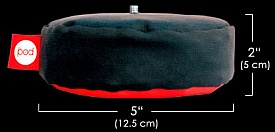 The Pod is essentially a fancy-pants version of the classic “beanbag tripod,” a device that photographers have been using for years as a makeshift tripod. The Pod people claim that The Pod “takes the shake out” and is a “breakthrough in effortless camera set-up.” Continue reading my review to find out what I thought of it and to have a shot at winning your own Pod.
The Pod is essentially a fancy-pants version of the classic “beanbag tripod,” a device that photographers have been using for years as a makeshift tripod. The Pod people claim that The Pod “takes the shake out” and is a “breakthrough in effortless camera set-up.” Continue reading my review to find out what I thought of it and to have a shot at winning your own Pod.
A tripod is the usual answer to the problem of making sharp photographs at slow shutter speeds. When used properly, a good tripod is difficult to beat in terms of holding your camera still. The trouble is that a good tripod is large, heavy, and cumbersome. Also, tripods aren’t allowed in many venues where you may want to take photographs. Enter the humble beanbag. Small, lightweight, unobtrusive, allowed anywhere. A beanbag can make a great camera platform. They’re easy to use and are very versatile. They can be used directly on the ground, on a nearby post or fence, on a window sill. They’re flexible so you can achieve a variety of camera angles. And they’ll protect your equipment from scratches.
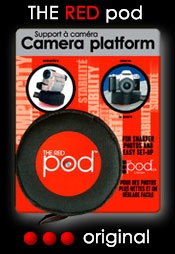 So, what’s The Pod got that a cheap, made-at-home beanbag doesn’t? Unlike your standard bean bag, The Pod includes a 1/4″ universal bolt that will allow you to attach your camera directly to it. That’s pretty handy when you plan to use the Pod a lot since it allows you to carry the camera and Pod as a single unit. It also has a non-slip base and is water-resistant.
So, what’s The Pod got that a cheap, made-at-home beanbag doesn’t? Unlike your standard bean bag, The Pod includes a 1/4″ universal bolt that will allow you to attach your camera directly to it. That’s pretty handy when you plan to use the Pod a lot since it allows you to carry the camera and Pod as a single unit. It also has a non-slip base and is water-resistant.
The Pod comes in three sizes/designs: Yellow, Blue, and Red. The Yellow and Blue Pods measure 3.75 inches across (9.5 cm). The Blue Pod is made especially for cameras with off-center tripod mounts. The Red Pod is 5 inches across (12.5 cm) with a centered bolt. This is a review of the Red Pod.

Pod with D70. The D70 dwarfed The Pod.
My initial impression when I received The Pod was that it was very small. And it seemed even smaller when I attached it to my Nikon D70. But with a 50mm lens attached, it actually did okay. It was able to support both the D70 and lens in an upright, level position for shooting. Don’t think about attaching anything longer though. The Pod couldn’t support even the lightweight 18-70mm DX zoom. And it wasn’t able to hold the D70 in as many different positions as a smaller camera. It would do in a pinch, but it was obviously meant for smaller cameras.

Pod with D70 in a tree. Looks a little silly, doesn’t it? But it worked!
The Pod fared much better with a small compact camera, in this case, my beat up, old Canon S50. The Pod was obviously designed for the compact camera market. It could support the S50 on a number of surfaces and was able to position the camera at any angle from straight up (90 degrees) to nearly straight down (about 60 degrees). The Pod was also able to hold the camera tilted at about a 45 degree angle to either side.

It held its position well on this curved, steel surface.
The Pod is closed with Velcro which makes it easy to open up and replace or remove the contents. You might do this if you want to make it ultra-portable, say for a hiking trip, by removing the beans and then filling it up when you reach your destination with whatever is handy (sand, tree bark, whatever).
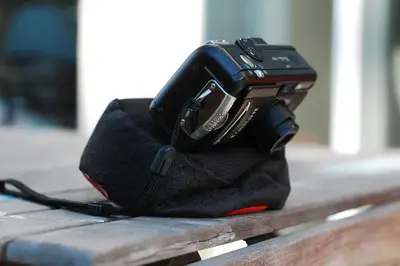
It can aim the camera at about a 60 degree maximum down angle.
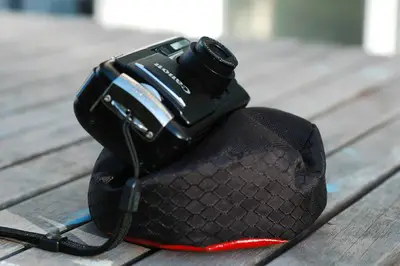
The camera can be angled straight up.
The Pod is very well constructed and felt sturdy in my hands. It looks nice and is obviously professionally manufactured. It didn’t feel like it would be falling apart any time soon and I had no qualms about throwing it around. The Velcro seal and stitching are very strong and held all of the beans in even after repeated 20 foot drops onto a wood floor.
But does it “take the shake out?” I setup the Pod with the S50 on the ground for a macro shot in fading dusk sunlight.
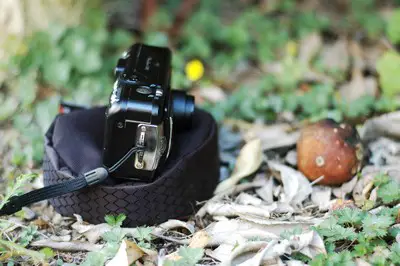
The Pod is easy to use directly on the ground and in cramped spaces.
The exposure was 1/15s at f/2.8, far too slow for hand-holding. I made the shot by positioning the camera on the Pod, composing the shot, and using the camera’s self-timer. The resulting photo was razor sharp. The Pod will be as stable a platform as whatever you put it on.

Pod macro. 1/15s @ f/2.8
The dark blur at the bottom of the frame is the edge of The Pod. It’s possible to
mash down the edges of The Pod so that it doesn’t interfere with your shot but
I didn’t notice it until after I’d already made this photo.
It’s an interesting product. It’s too small to be practical for a DSLR but works well with compact cameras. A major advantage The Pod has over a tripod is in situations where tripods are simply not allowed. It’s also much lighter than a tripod and very small and easy to carry around. It works extremely well close to the ground and in cramped spaces. As for holding the camera still during an exposure, it performed at least as well as a tripod. It should be as stable as whatever surface you put it on—if you put it on a rock it will be as stable as, well, a rock. Positioning the S50 on top of The Pod felt a bit like using a tripod ball head but wasn’t as precise. Aside from the snazzy looks and universal bolt (which, admittedly, is very handy if you intend to use it a lot), it doesn’t have a whole lot that a cheaper bean bag couldn’t give you. I bought mine at B&H for $15.









I have never seen or heard of this product, probably not available in Ireland yet! It seems like a good enough idea but a bit cumbersome/bulky? I have a fantastic little mini tridod, about 6 inches long with bendy legs. it fits in my pocket or the bottom of my handbag and its the only job!
Nice review. Could have done with one of these on many shots-have been using a stack of coins instead so far!
Cool idea. I want to look for one of those mini tripods to that bobbygreg mentioned.
Interesting product. I am in Hanoi. I don’t have opportunity to try this product so I wonder which Pod version will be suitable for my Canon EOS with BP300 battery pack and often use len EF 24-70 f/2.8? Please give me your suggestions. Thanks.
I had been wondering which works better. The Pod Green or Gorrila Pod SLR-Zoom. No one had did such a comparison yet.
Thanks.